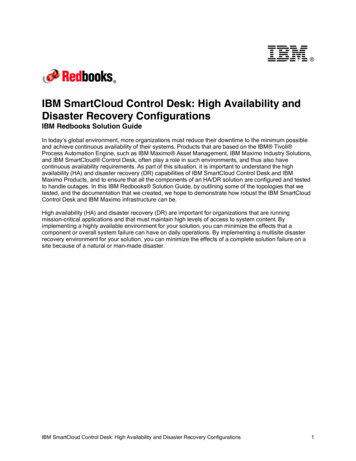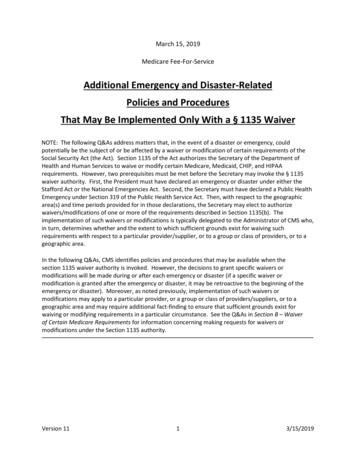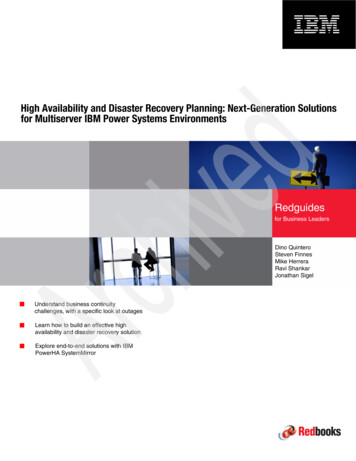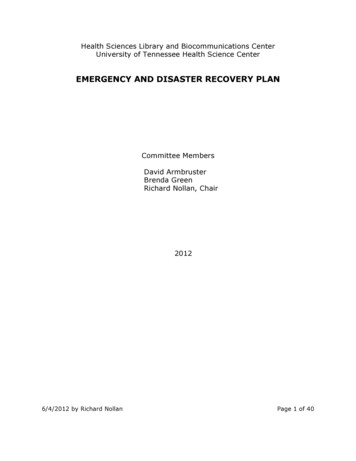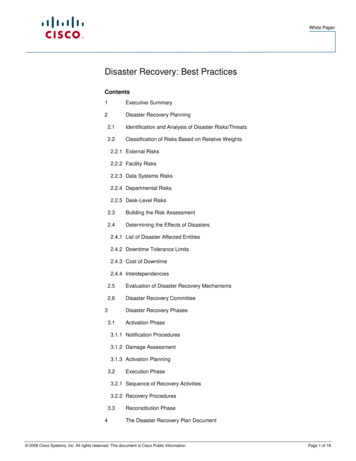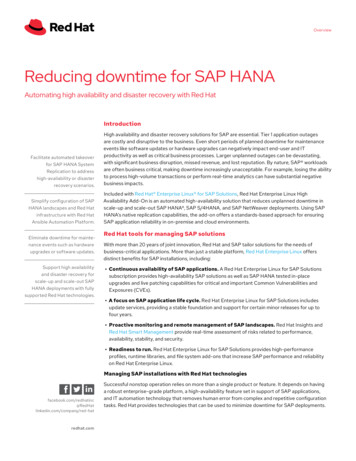
Transcription
OverviewReducing downtime for SAP HANAAutomating high availability and disaster recovery with Red HatIntroductionFacilitate automated takeoverfor SAP HANA SystemReplication to addresshigh-availability or disasterrecovery scenarios.Simplify configuration of SAPHANA landscapes and Red Hatinfrastructure with Red HatAnsible Automation Platform.Eliminate downtime for maintenance events such as hardwareupgrades or software updates.Support high availabilityand disaster recovery forscale-up and scale-out SAPHANA deployments with fullysupported Red Hat technologies.High availability and disaster recovery solutions for SAP are essential. Tier 1 application outagesare costly and disruptive to the business. Even short periods of planned downtime for maintenanceevents like software updates or hardware upgrades can negatively impact end-user and ITproductivity as well as critical business processes. Larger unplanned outages can be devastating,with significant business disruption, missed revenue, and lost reputation. By nature, SAP workloadsare often business critical, making downtime increasingly unacceptable. For example, losing the abilityto process high-volume transactions or perform real-time analytics can have substantial negativebusiness impacts.Included with Red Hat Enterprise Linux for SAP Solutions, Red Hat Enterprise Linux HighAvailability Add-On is an automated high-availability solution that reduces unplanned downtime inscale-up and scale-out SAP HANA , SAP S/4HANA, and SAP NetWeaver deployments. Using SAPHANA’s native replication capabilities, the add-on offers a standards-based approach for ensuringSAP application reliability in on-premise and cloud environments.Red Hat tools for managing SAP solutionsWith more than 20 years of joint innovation, Red Hat and SAP tailor solutions for the needs ofbusiness-critical applications. More than just a stable platform, Red Hat Enterprise Linux offersdistinct benefits for SAP installations, including: Continuous availability of SAP applications. A Red Hat Enterprise Linux for SAP Solutionssubscription provides high-availability SAP solutions as well as SAP HANA tested in-placeupgrades and live patching capabilities for critical and important Common Vulnerabilities andExposures (CVEs). A focus on SAP application life cycle. Red Hat Enterprise Linux for SAP Solutions includesupdate services, providing a stable foundation and support for certain minor releases for up tofour years. Proactive monitoring and remote management of SAP landscapes. Red Hat Insights andRed Hat Smart Management provide real-time assessment of risks related to performance,availability, stability, and security. Readiness to run. Red Hat Enterprise Linux for SAP Solutions provides high-performanceprofiles, runtime libraries, and file system add-ons that increase SAP performance and reliabilityon Red Hat Enterprise Linux.Managing SAP installations with Red Hat com/company/red-hatredhat.comSuccessful nonstop operation relies on more than a single product or feature. It depends on havinga robust enterprise-grade platform, a high-availability feature set in support of SAP applications,and IT automation technology that removes human error from complex and repetitive configurationtasks. Red Hat provides technologies that can be used to minimize downtime for SAP deployments.
They include: Red Hat Ansible Automation Platform, which automates IT processes and deployments with asimple and powerful language that requires no agents to install. Red Hat Satellite, which helps you build a trusted Red Hat environment and manage the Red Hatlife cycle—standardizing your environment while provisioning and configuring at scale. Red Hat Insights, which helps put SAP on a firm foundation by preventing critical issues beforethey occur with continuous insights, verified knowledge, and proactive resolutions.1Use case: Fast patching of SAP landscapesRapid routine configuration and patching of SAP landscapes are critical to minimizing downtime.Figure 1 shows how an Ansible Playbook can be used to provide patching of an SAP landscape on aquality assurance (QA)/test server, with eventual promotion to production. As shown in Figure 1, theplaybook is broken down into roles for each of the component technologies, with distinct functionality:21.Red Hat Virtualization roles are used to apply production server and boot profiles.2.Red Hat Satellite roles install the operating system (OS) on the QA server.3.Red Hat Enterprise Linux roles apply the production OS configuration on the QA server.4.Red Hat Ansible Automation Platform roles for SAP are used to provision and configurethe application.5.Finally, storage roles load test data.Once the tests are vetted on the QA server, the patch can be promoted to production and deployedby Red Hat Satellite.Run Ansible PlaybookRun tests andrecord resultsPromote patch toPROD if, OKRun updateon PRODAnsible RolesFigure 1. Red Hat Ansible Automation Platform helps provide fast and reliable patching of SAP landscapes.1 Red Hat Insights is included as part of your Red Hat Enterprise Linux subscription, so you can start proactively identifyingand remediating risks across your Red Hat infrastructure from the moment the operating system is deployed.2 Find additional ready-to-use Ansible roles at the following links: /galaxy.ansible.com/linux-system-roles, .comOverview Reducing downtime for SAP HANA2
SAP automation with Red Hat Ansible Automation PlatformRed Hat Ansible Automation Platform provides a number of specific roles for SAP automation(Figure 2). Ansible Roles are the primary mechanism for breaking Ansible Playbooks into smallerreusable components. Roles provide a framework for fully independent tasks, or independentcollections of variables, files, templates, and modules. Each role is limited to a particular set offunctionality or desired output, with all of the necessary steps to provide that result either definedwithin the role, or in other roles that are listed as reconfiguresap-netweaver-preconfigureTech previewsap-hana-preconfigureOther Red Hat Enterprise Linux system roles for network,Network Time Protocol (NTP), subscription management, etc.Figure 2. Ansible Roles for SAP environments provide for fully automated SAP deployment and management.As pictured, Ansible Roles for SAP environments include the following: sap-hana-preconfigure performs additional configurations for SAP HANA that have not beendone by sap-preconfigure. sap-netweaver-preconfigure prepares the system for NetWeaver installation. sap-preconfigure configures system locale and host name and checks the Domain Name Service(DNS) according to basic SAP Notes for a generic operating setup for SAP. sap-hana-mediacheck checks for SAP installation media availability and returns version information that can be used by the sap-hana-hostagent and sap-hana-deploy roles. sap-hana-hostagent installs/updates the SAP Host Agent (if applicable). sap-hana-deploy creates SAP HANA-specific users and launches an SAP HANA unattendedinstallation for all supported scenarios. sap-hana-hsr creates an initial backup for SAP HANA System Replication (HSR) and configuressystem replication between two SAP HANA instances.redhat.comOverview Reducing downtime for SAP HANA3
High availability and disaster recovery options for SAP HANAThere are multiple ways to configure SAP HANA for high availability and disaster recovery. Choosingthe right option depends on performance and cost sensitivity, and what problems you are trying tosolve with a high-availability solution. Configuration options include: Host auto-failover. Host auto-failover is a cluster-like solution that uses a single data pool. Itincludes an internal cluster manager for micro cosmos auto-failover. Storage connector APIscommunicate with storage area network (SAN) storage. Host auto-failover covers hardwareproblems by providing additional hosts. Technically, this approach represents a “scale-out”multimode solution. System replication. SAP HSR is similar to classical shadow database solutions and is suitable forhigh availability and disaster recovery scenarios. Failover is not automated by default, thoughautomation is possible with a cluster manager, like Pacemaker, and Red Hat Ansible AutomationPlatform. System replication covers hardware and data integrity problems by providing anadditional set of individually driven data pools. Storage replication. Storage replication is typically used for multisite disaster recovery.Automation is possible with an external cluster manager (macro cosmos). Storage replicationcovers datacenter-level failures on a broader scale.Choosing a strategy for high availability and disaster recovery depends on priorities for performance,cost, recovery point objectives (RPO), and recovery time objectives (RTO). Table 1 compares hostauto-failover with SAP HSR.Table 1. Host auto-failover vs. SAP HANA System ReplicationHost auto-failoverSAP HSRLeast expensive optionFully redundantProvides zero RPO but high RTOAllows zero RPO and low RTOOnly covers the failure of compute nodes.Storage is shared through a SAN.Nothing is shared. High availability and disasterrecovery instances are fully provisioned SAPHANA scale-up or scale-out deployments.Automating SAP HANA System Replication with Red HatWith standard SAP HSR, all data is replicated to a secondary SAP HANA system (Figure 3). Datais constantly preloaded on the secondary system to minimize RTO in the event of a failure event.Failover is not automated by default and requires a third-party cluster solution. SAP HANA scale-upand scale-out configurations are supported.SAP HSR takeover can be automated using Red Hat Enterprise Linux High Availability Add-On. Inaddition, Red Hat Ansible Automation Platform can automate many SAP tasks, including the setupand configuration of the SAP HSR running in Red Hat Enterprise Linux High Availability Add-On, andon the Pacemaker cluster.redhat.comOverview Reducing downtime for SAP HANA4
Automatic initial data loadSAP HANA - primary(active)MemorySAPHANALogvolumesTransfer bySAP HANAdatabase kernelSAP HANA - secondary(active, data preloaded)MemoryRedoLogDatavolumesPersistent storageSAPHANALogvolumesDatavolumesPersistent storageFigure 3. SAP HANA System Replication topology, utilized in both scale-up and scale-out configurations.SAP HANA scale-up configurationsFor scale-up configurations, automated SAP HSR assumes a two-node cluster as shown in Figure 3.SAP HSR supports different modes of operation, which can be configured depending on the needsof the organization: Cost-optimized configurations support a QA/test instance running on the secondary site. TheQA/test instance is shut down during failover events. SAP HANA 2.0 supports active/activeconfigurations where the secondary instance can take read-only inquiries. Performance-optimized configurations feature a secondary site that is dedicated to failover, andis not active to client/application servers. Multi-tier system replication (aka “replication chains”) is also possible; however, the tertiary sitecannot be managed by the cluster. Resource agents are available to aid with the systemreplication process. 3Use case: Near-zero downtime maintenance for SAP HANAAnsible Playbooks and Red Hat Satellite provisioning can allow SAP HANA software updates orhardware maintenance with zero downtime. For example, in a scale-up scenario, a virtual IP address isassigned to the primary node, with synchronous data replication to a secondary node. The secondarynode might be supported by updated hardware, or it might run a more recent software version.Using the SAP NetWeaver suspend connection API, the Ansible Playbook suspends the connectivityof the appropriate node. Once database connectivity is suspended, Red Hat Ansible Playbooksinstruct the cluster manager to take over the secondary node as a prefered site. After the primarynode is down, system replication is interrupted, and the Pacemaker cluster fences the primary node.The secondary node then becomes the new primary node, and the virtual IP address binds to the new3 Available in the resource-agents-sap-hana RPM.redhat.comOverview Reducing downtime for SAP HANA5
OverviewAbout Red Hat ed Hat is the world’s leadingRprovider of enterprise opensource sof t ware solutions,u sing a communit y-powereda p p roach to d el i ver rel ia b leand high-per forming Linux,hybrid cloud, container, andKubernetestechnologies.Red Hat helps customers integratenew and existing IT applications,develop cloud-native applications,standardize on our industry-leadingoperating system, and automate,secure, and manage complexenvironment s . Award-winningsupport, training, and consultingservices make Red Hat a trustedadviser to the Fortune 500. As astrategic partner to cloud providers,system integrators, applicationvendors, customers, and opensource communities, Red Hat canhelp organizations prepare for thedigital future.North America1 888 REDHAT1www.redhat.comprimary node. As the dual-primary state times out, the former primary registers as the newsecondary node. System replication then restarts in the opposite direction, replicating from thenew primary node to the new secondary node.Prerequisites for this use case include the following: SAP NetWeaver 7.40 Support Package 5 or higher SAP Kernel 7.41 or higher SAP Note 1913302 - SAP HANA: Suspend DB connections for short maintenance tasks An SAP HANA system landscape with SAP HSRSAP HANA scale-out configurationsFor SAP HANA scale-out configurations, automated SAP HSR is supported between two scale-outsites (Figure 4), starting with Red Hat Enterprise Linux 7.6 or later.Client/application serversVIPW1MajoritymakerW2W3Europe, Middle East,and Africa00800 7334 2835europe@redhat.comAsia Pacific 65 6490 4200apac@redhat.comS1W1W3S1System replicationPrimary datacenterLatin America 54 11 4329 7300info-latam@redhat.comW2Secondary datacenterPacemakerFigure 4. Automated SAP HANA System Replication scale-out system tlinkedin.com/company/red-hatredhat.com#F22788 0420The combination of SAP HSR and Red Hat subscriptions for Red Hat Enterprise Linux for SAP Solutionsenhances the ability to operate SAP HANA landscapes with less downtime. Long-term collaborationbetween Red Hat and SAP makes Red Hat Enterprise Linux for SAP Solutions an ideal platform forhosting enterprise-critical SAP HANA deployments. Red Hat Ansible Automation Platform providesa wealth of SAP-specific roles for automating SAP HANA landscapes. The combination of Red HatAnsible Automation Platform with Red Hat Enterprise Linux for SAP Solutions make it possible toautomate critical transitions like system and software upgrades, with near-zero downtime.Copyright 2020 Red Hat, Inc. Red Hat, the Red Hat logo, and Ansible are trademarks or registered trademarks of Red Hat, Inc. or itssubsidiaries in the United States and other countries. Linux is the registered trademark of Linus Torvalds in the U.S. and other countries.All other trademarks are the property of their respective owners.
High availability and disaster recovery options for SAP HANA There are multiple ways to configure SAP HANA for high availability and disaster recovery. Choosing the right option depends on performance and cost sensitivity, and what problems you are trying to solve with a high-availability solution. Configuration options include: Host auto .

